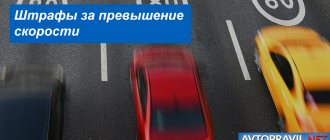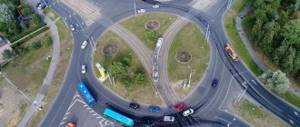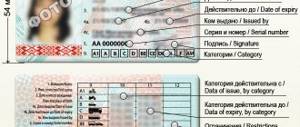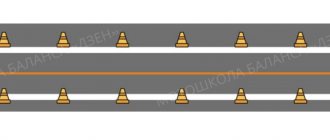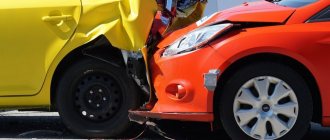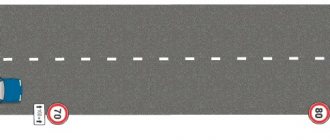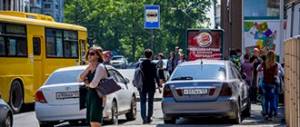09.11.2020
no comments
7880
A safe distance when driving cars plays an important role. Drivers who ignore maintaining a safe distance not only endanger themselves and their car, but the health of other road users. In addition, when investigating the circumstances of an accident, the fact of violating a safe distance threatens that the driver will be found guilty of the incident and be subject to a large fine. To avoid getting into such a situation, you need to know a number of nuances related to safe distance and lateral spacing.
Let's understand the definition
The traffic rules contain clause 9.10, which provides a clear definition of “safe distance” and “lateral interval”. What is noteworthy is that this paragraph has remained unchanged for 25 years. However, it is written quite vaguely. This fact does not indicate that the clause is imperfect, but that it is impossible to collect all the nuances within the framework of a short formulation of the rules.
As a result, the traffic rules are written simply - the driver is obliged to maintain such a distance and lateral interval that will allow him to avoid a collision. No numbers or specific distances are indicated, but what distance should be between cars in meters for safe movement and how to maintain it?
Braking distances
In addition to determining a safe distance, you also need to know what a braking distance is (there is no definition of this in the traffic rules). Braking distance is the distance traveled by a vehicle from the moment you press the brake pedal until it comes to a complete stop. The value of this indicator can be influenced by several dozen factors, from weather conditions to the presence of electronic assistants in the car.
Penalty for violation
It is also important to remember that there is a fine for failure to comply with traffic rules. He is discharged only after an accident has occurred. It is 1,500 rubles if it was determined that the driver did not maintain the proper distance from the vehicle in front. This is often observed in urban environments, when everyone is trying to squeeze through and pass faster.
There are several types of non-compliance: incorrect speed and distance. It should be remembered that traffic regulations do not contain a clear algorithm of actions in various situations, but only approximately indicate acceptable distance parameters. Therefore, the driver needs to be careful when choosing the appropriate distance depending on the road situation and external factors. It is important not to overestimate your abilities, otherwise when the car in front suddenly brakes, there is a high probability of not reacting properly and getting into an accident.
Source
How is the safe interval calculated?
Since there are no specifics in the traffic rules, the driver must independently determine the value of the safe distance. This is a difficult task, since the distance will dynamically change under the influence of several factors - vehicle speed, weather conditions, installed tires.
There are several common ways to determine this value by eye. They can be used for rough estimation.
Speed in two
The first method was used by our grandfathers, when there was no precise electronics that would help keep the distance to the vehicle in front. The technique usually appeared in old Soviet textbooks for drivers and is called “Speed in two.”
The calculation is very simple - take the current speed on the speedometer and divide by 2. The resulting figure is the safe distance to the car in front. For example, a driver is driving at a speed of 90 km/h, respectively, 90 / 2 = 45 meters - this is the safe distance to the car in front.
Important to consider! This calculation only works correctly in dry road conditions. As soon as the asphalt gets wet due to rain or loose snow falls, the technique stops working.
Two Second Rule
Why is it inconvenient to determine a safe distance in meters? Because without electronics it is quite difficult to soberly assess the actual distance “by eye”, and the chance of making a mistake increases. Often different drivers mistake it for 50 meters by eye - 30 or even 20 meters in reality.
You can start from time, since it is easier to count seconds correctly than meters. We select a noticeable landmark on the road and watch the moment when the car in front passes it. At the same time, count down 2 seconds in your mind. If, after the countdown, the landmark is behind us, then it is necessary to increase the distance; if it is not, then reduce it.
Why exactly 2 seconds? These are the average times it takes a driver in an emergency:
- To realize that the situation is urgent and urgently requires action - 0.8 seconds;
- In order to perform any urgent action (turning the steering wheel or hitting the brakes) – 0.2 seconds.
- An additional second is intended for those drivers who are slow to react to their surroundings.
This technique can also only be used on dry road surfaces. If it rains, then the rule turns into “3 seconds”, and if it snows, then into “6 seconds”. On a night road, the safe interval is generally the limit of the light spot from the headlight.
What affects a driver's reaction time?
Since everyone is different, everyone's reaction time is different. The reaction time can be affected by:
- Gender – on average, men react to a critical situation 0.05 seconds faster than women;
- Age – young drivers require less time to react;
- Regular training helps to develop a reaction and, accordingly, behave faster in a critical situation;
- Adverse weather conditions slow down the reaction by 1.5-2 times;
- Taking medications, alcohol, drugs - significantly increase the reaction time, up to a complete lack of reaction to a critical situation;
- Overfatigue reduces reaction time by 0.1-0.4 seconds.
Distance according to traffic rules
When driving a car on public roads, the distance and speed are chosen directly by the driver. He needs to be guided by his own driving experience, as well as correctly assess the current weather conditions. According to current rules, the distance between vehicles varies depending on the traffic situation. There are several concepts that are worth distinguishing:
- Minimum allowable distance.
- Permitted gap in the city, as well as on the highway.
- Other types of distances.
Minimum
Considering what the distance between cars should be when driving according to traffic rules in the most ideal situation, it cannot be less than 3 m. However, in bad weather, for example, rain, this distance needs to be increased by 4 times. At the same time, depending on the condition of the road surface, the minimum distance should change.
Drivers without sufficient experience in driving a vehicle should maintain a distance of at least 8 m . Thanks to this, they will be able to react in time to sharply changing road conditions.
In the city
Traffic on a city road is often much more dynamic than on a highway. It is characterized by frequent acceleration and braking at traffic lights and pedestrian crossings. It is because of this that it is more problematic to keep the correct distance. Therefore, it is recommended to drive at a distance of at least 3 m from the vehicle in front, and for inexperienced drivers, 5 m. The latter is due to the lack of a proper reflex reaction in such people to the sharply decreasing distance between cars. Given the dynamism of the urban environment, it is necessary to remember the current traffic regulations.
On the road
When driving outside the city, it is important to take into account weather conditions, as well as the quality of the road surface. The main criteria when assessing the permissible distance on the route are:
- There are no serious obstacles on the route, for example, blocked areas due to repairs or polluted areas. The permissible distance relative to the vehicle in front is 3 m.
- If there are potholes, uneven spots on the road surface or driving at night, the distance can be kept at least 5 m.
- When the asphalt is icing during the day, the distance should start from 6 m, at night from 7 m.
- In conditions of precipitation, especially snow, the minimum permissible distance for passenger vehicles is 7 m.
When driving, you need to take into account the road conditions
At the traffic light
The current traffic regulations state that the driver is required to maintain a distance that will prevent an emergency situation on the road. For this reason, you should not drive too close to the cars in front at a traffic light in order to avoid an accident. To do this, it is important to maintain a distance of 2-3 m at busy intersections. This will allow, in the event of a collision with one of the cars, not to hit the other. In addition, this situation reduces the likelihood of an accident during the process of changing lanes.
In a traffic jam
When the driver has sufficient experience in driving a vehicle, he has no problem correctly determining the distance that is half the car. But for inexperienced people who recently received their license, it is recommended to maintain a distance of at least 2/3 of the length of their car. This situation will prevent someone else's car from changing lanes into this area.
When stopping
When determining a safe distance during a forced or planned stop, one should proceed from the following parameters:
- Road conditions.
- Quality and seasonality of car tires.
- How is the movement of oncoming vehicles organized?
- When the maximum distance must allow a complete stop within 5 seconds.
While driving, any vehicle may suddenly experience breakdowns or malfunctions. In such a situation, you need to turn on the hazard warning lights, change lanes to the far right, and then drive to the nearest workshop.
In the parking lot
Unlike many countries (for example, Israel), in Russia there are certain generally accepted standards of adequate and polite behavior in parking lots. The distance between the cars should allow the driver to drive out normally without hitting the vehicles standing nearby. In addition, the opportunity to park exists only in strictly designated places:
- Before or after the intersection at a distance of 5 m.
- 15 m before or after a public transport stop.
- 50 m after the railway crossing.
- If there are no prohibiting signs or yellow markings, you can stop on the side of the road.
- In courtyards or parking lots of shopping centers, strictly follow the markings.
In the latter case, each place to stop the car is clearly separated. And although this situation is not described in the traffic rules, it is recommended to adhere to the following simple rules:
- The distance between parked cars should not interfere with the exit of your own car.
- There should be no obstacles or restrictions for the movement of other vehicles.
- When parallel parking, the recommended distance from the car to the curb is 0.5 m, and from the nearest cars 1.5 m, so that you can easily enter the traffic lane.
When driving or parking, it is always important to take into account the lateral interval. This is often more relevant when overtaking occurs on highways with multiple lanes. This distance is determined by the dimensions of the car, its technical condition, as well as external factors.
Lateral spacing
When determining the distance for the lateral interval, no calculations are required at all. The larger it is, the safer the movement. The driver must be in the middle of the selected lane (in the absence of obstacles or obstacles). Modern cars have a system of sensors for monitoring blind spots - do not neglect it.
Attention! By paying attention to the sensor signal, you can quickly train yourself to maintain a safe lateral interval.
If an accurate calculation is still required, then driving textbooks recommend maintaining a lateral distance from the other car of approximately half the width of your own. In city traffic, you can keep a smaller distance, but be mindful of motorcyclists. Among those who like to drive in heavy traffic between cars, there will definitely be someone who will scratch your car and report non-compliance with the lateral interval. To avoid this, you need to move strictly in the center of the lane.
Important! Consider the value of the lateral interval if you notice a cyclist (moving along the edge of the roadway) or a pedestrian (moving too close to the side of the road). It will be safe to drive around a potential obstacle at an interval of 1.5 meters.
Why learn to feel the dimensions of a car?
A complete feeling of your car gives you a feeling of comfort and safety. Therefore, a woman wants to learn how to drive a car from scratch just as much as a man. Also, a clear awareness of the dimensions of the car allows you to move in traffic, overtake vehicles in front and avoid obstacles. When entering a garage, good spatial orientation will allow you to stop the car in time, positioning it so that you can get out of the car and close the gate.
Parking lots in public places can be densely crowded with other people's vehicles; you need to be able to park your car correctly without affecting the environment.
There are two types of dimensions:
- Dynamic;
- Static.
The dynamic dimension of a vehicle is the distance from the obstacle to the body. As the driver approaches the object, it is necessary to calculate the trajectory of its movement. This skill allows you to avoid collisions with curbs, trees, fences and other cars.
Static dimensions are the dimensions of the car, its main unchanged parameters.
Safe distance values
In order to determine the exact numbers of a safe distance, practical tests are used at testing grounds. This takes into account a number of conditions, including the type of tires, driving speed, road condition, driver reaction time, etc. Here is an example of calculating the average safe distance.
Under initial conditions, a passenger car (105 hp) with 14-inch summer tires. The speed is 95 km/h. A series of tests show braking distances from 32 to 38 meters. An average value of 35 meters is taken. Additionally, tests are carried out on roads with smooth asphalt, where the braking distance has increased by an average of 5 meters (40 meters in total). We also add those 2 seconds during which the driver must understand that an emergency is approaching and he needs to slow down. At a speed of 95 km/h this is 49 meters. The final figure for the given conditions is 89 meters ( safe distance ).
The table shows test results for other road surface conditions:
| Vehicle speed, km/h | ||||
| Road conditions | 35 km/h | 65 km/h | 85 km/h | 105 km/h |
| A car on summer tires drives on a dry road | 30,7 | 57,0 | 74,5 | 92,0 |
| A car rides on summer tires on a wet road | 29,3 | 54,4 | 71,2 | 88,0 |
| The car rides on Velcro on a dry road | 31,5 | 58,4 | 76,4 | 94,4 |
| The car rides on Velcro on a wet road | 28,7 | 53,4 | 69,8 | 86,2 |
| The car rides on Velcro on snow or ice | 24,6 | 45,7 | 59,8 | 73,9 |
| A car with studded tires drives on a dry road | 31,1 | 57,7 | 75,5 | 93,3 |
| A car on studded tires drives on a wet road | 27,5 | 51,1 | 66,8 | 82,5 |
| A car with studded tires drives in snow or ice | 31,8 | 59,0 | 77,2 | 95,4 |
Please note that these are theoretical calculations and may not take into account, for example, the level of wear on your vehicle's brake system. And in reality, maintaining a distance of 95 meters will be problematic - some person in a hurry will definitely try to wedge themselves into the created space.
Safe distance in different conditions
In order to simplify life for drivers and save them from unnecessary calculations, we provide approximate values of the safe distance (in meters) for different conditions:
- On a wet road at 60 km/h (for a passenger car) – 35 meters;
- In the city at 60 km/h - at least 40 meters;
- On a country road - at least 50 meters;
- In a traffic jam - at least 10 meters;
- When stopping – at least 30 meters;
- In the parking lot - at least 5 meters;
- For a truck - on average 2 times more than for a passenger vehicle, but not less than 60 meters;
- At a traffic light, it is enough to leave the opportunity to pass cars without using reverse gear if the car in front suddenly stops or stalls.
Effective speed on the highway under different circumstances
In addition to the braking distance under different conditions, it would be useful to know about the effective speed on the highway under different circumstances. Typically, authorized bodies set limits on highways and determine effective speeds. Here are a number of factors that influence this:
- Speed of individual reaction to a critical situation;
- Experience and level of awareness of the road situation;
- Presence of speed restrictions on the site;
- Awareness of the risk of accidents;
- Manufacturability of the vehicle;
- Road condition;
- Driving conditions.
The effective speed on the highway is 90 km/h, in the absence of any interfering factors.
What should be the distance between cars in meters?
Unfortunately, the number of meters is not explained in the traffic rules. New drivers in this matter have to study the experience of old-timers.
In practice, there are situations when it is necessary to increase the permissible parameters. Examples:
- The car moves on wet asphalt.
- The car is moving in icy conditions.
- There was snow on the highway.
- The car is driving behind a long row of cars, including more than 4-5 types of transport.
- The view of the road section is difficult due to weather anomalies or steep ascents and descents.
- The driver is forced to increase speed.
- The road is made of dirt and it started to rain.
Why drive close to cars? After all, in our country many roads have multi-lane traffic. And most drivers will not be happy with this “in a vice” position, since it does not provide freedom of choice and deprives many privileges:
- Restricts view.
- There is not enough space for overtaking, turning and other maneuvers.
- There is no room for emergency braking.
The latter circumstance becomes the cause of accidents that occur in traffic. Even a citizen stuck in a traffic jam is not immune from force majeure. To avoid a collision, you need to master the simplest rules of calculation.
Method No. 1
As a rule, an experienced driver advises taking the vehicle speed as a basis when calculating the effective value. This value is divided by 2. This is the distance that should be maintained between nearby standing (moving) cars.
Method number 2
Insurers recommend maintaining a safe yardage to the next vehicle at all times, which is approximately 2/3 of the vehicle's length. This is an average of three meters. For non-amateurs, it is permissible to reduce this figure to two meters, but lower values lead to a dangerous situation.
Sign "Minimum distance limit"
Cases when the driver needs to determine the safe distance to the vehicle in front are more or less clear. But on some sections of the road you can find a sign that strictly regulates the distance between cars. This is necessary, for example, to ensure effective road capacity in difficult areas (traffic police post or checkpoint). The sign can also be found on sections of the road with increased danger - mountain tunnels, ice crossings and bridges.
The sign indicates a number in meters, which should be strictly observed by drivers moving in a convoy. In this case, this also applies to vehicles driving in the same lane. The sign is valid:
- To the first intersection on the way;
- Until the end of the settlement;
- Until the sign lifting all restrictions.
What is distance in traffic rules: definition
According to traffic regulations, it is customary to call the driving distance from one car to another a distance without risk. As a rule, in modern road conditions there is always a car in front, and the risk of an accident is excluded only in one case: a gap must be provided before it that is sufficient for braking. Most collisions occur precisely because of the short braking distance between cars. The driver does not have time to orient himself when the front participant brakes sharply. In more severe cases, this leads to a chain reaction and several cars crash in a row, for example, in winter or in the rain.
Thus, the concept of “distance” is relevant for motorists moving after other participants along the same trajectory. However, equally important is determining the speed of movement.
- According to traffic regulations, when determining the shortest distance between cars when driving, the speed of the vehicle is taken as a fundamental criterion. This value is divided by 2, and the most optimal distance is displayed.
- Any experienced driver automatically slows down when approaching cars in front.
- Insurance agents recommend defining safe footage as two-thirds of the length of the car body.
Responsibility for failure to maintain distance
Failure to keep the distance will result in a fine. An important point is that most of these fines are issued after the fact, when the driver caused a collision due to non-compliance. To bring to justice, traffic police inspectors use Article 12.12 of the Code of Administrative Offenses (violation of the rules for positioning a car on the road), according to which the maximum penalty is 1,500 rubles.
You cannot receive a fine for not keeping the distance if there is no incident. The inspector will issue a penalty only if this led to an accident. If the circumstances are such that they are trying to issue you a fine for failure to keep the distance without the fact of an accident, this is a reason to appeal the inspector’s decision in court.
In some cases, a fine may also be issued to the motorist who was driving ahead. This could be a deliberate emergency braking that was not meant to be done. That is, the driver did not brake urgently to prevent a collision. To prove this fact, dash cam footage or witness testimony is required.
It is also worth discussing fines for non-compliance with the lateral interval. A situation often arises when a driver moving in the adjacent lane changes lanes abruptly and without the turn signal on. In this case, the inspector can issue a fine under Article 12.15 to the one who was driving in his lane, and not to the one who was changing lanes. This decision must be appealed, since there is clearly a violation of the rules of maneuvering (clause 8.1 of the traffic rules). Attach DVR footage or witness statements as evidence.
There are several cases in which punishment for not maintaining distance is not applied:
- One of the traffic participants did not move (for example, stood in the parking lot);
- The cars violated the distance, but this did not lead to a collision;
- One of the drivers was backing out.
Safety on the road directly depends on the actions of the driver. Maintaining a safe distance and lateral interval will avoid unnecessary troubles and protect all road users.
Share on social networks:
More useful on the topic
How to properly start a manual vehicle: step-by-step instructions for beginners
23.05.2021
How to properly adjust the side and interior mirrors of a car yourself
08.04.2021
How to understand the dimensions of a car: beginner mistakes
Even an experienced person can have problems with feeling the dimensions of a car if he gets behind the wheel of an unfamiliar vehicle. But most often, this difficulty is encountered by beginners who are just learning to drive and do not yet have experience. Driving school instructors almost every day hear complaints from students such as: I can’t feel the dimensions of the car, I don’t know the distance from the car to the obstacle.
There are many mistakes when developing this skill. It is worth considering the main ones:
- Trying to see what is directly in front of the bumper. Novice drivers move the seat closer to the steering wheel, practically resting against the glass, which is absolutely not worth doing. First of all, while driving, you need to monitor the situation on the road, and not under the wheels of your car. Only experience gained over time will help you adapt to the dimensions of your vehicle.
- Underestimating the importance of mirrors. One of the first skills that a driver must develop is the ability to use mirrors and know their features. Often, cars behind you appear smaller in the reflection, which creates the impression that they are far away. But this is just an optical illusion. Another feature of mirrors is that they have a blind spot. This is the name given to the space around a vehicle that is not in the driver’s field of vision. Before attempting to overtake or perform any other maneuver, you should always ensure that the situation is safe. It is worth remembering that the dimensions of trucks are larger, which means their “dead zone” is more extensive. Many accidents occur due to underestimation of these factors.
- Ignorance of transport features. Many novice drivers think that the distance from the driver's seat to the wheels is approximately the same. This is a misconception, because the distance to the right wheels is always greater than to the left.
Knowing these factors will help you understand how to get used to the dimensions of the car without spoiling the transport and environment.
